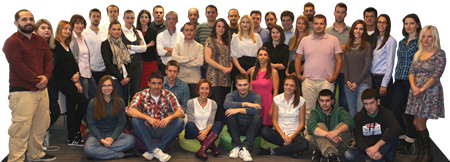Physics and the Physical Perspective: Hooper and Gwynne
| Cena: |
1.190 din
(Predmet je prodat)
|
| Stanje: | Polovan bez oštećenja |
| Garancija: | Ne |
| Isporuka: | Pošta CC paket (Pošta) Post Express |
| Plaćanje: | Tekući račun (pre slanja) |
| Grad: |
Novi Sad, Novi Sad |
ISBN: Ostalo
Godina izdanja: 1980
Jezik: Engleski
Oblast: Fizika
Autor: Strani
U dobrom stanju
Physics and the Physical Perspective
Authors Henry O. Hooper, Peter Gwynne
Edition 2, illustrated
Publisher Harper & Row, 1980
Weight: 2 kg
Physics and the Physical Perspective, second edition, is a textbook primarily for students who require a familiarity with but not an exhaustive knowledge of the science of physics: those who need the basics of physics for careers in medicine, dentistry, the biological sciences, agriculture, architecture, geology, oceanography, law, business, or as a general understanding of the physical world. Elementary physics texts and courses are often classified by the level of mathematics employed; this is a noncalculus text in which high school algebra is used extensively and trigonometry is used as necessary to provide insights and better understanding of the principles of physics. Because many students tend to have problems with the mathematics in this course, reviews of mathematical concepts are included where they are first used. In addition, Appendix A presents a detailed overview of mathematical concepts. Throughout the book, applications of a non-engineering nature should help students see the relevance of physics to their career goals.
Contents
Preface xi
Useful Information xiv
The Nature of Physics 1
1.1 From Archeology to Zoology 3
1.2 Recent and Modern 3
Special Topic: The Urge to Unify 6
Motion 7
2.1 Length 9
2.2 Time 13
2.3 Vectors 15
2.4 Speed and Velocity (A Scalar and a Vector) 22
2.5 Relative Velocities 23
2.6 Average Speed and Instantaneous Speed (Two Scalars) 27
2.7 Acceleration 29
2.8 Projectile Motion (Vectors in Two Dimensions)
Special Topic: Higher, Faster, Farther 52
Forces 55
3.1 Newton’s Laws of Motion 57
3.2 The Second Law 60
3.3 Mass and Weight 61
3.4 Units of Force 63
3.5 The Second Law in Action 65
3.6 Newton’s Third Law 66
3.7 Applying Newton’s Laws 69
3.8 Friction 77
Special Topic: Return to a Small Planet 88
Universal Gravitation 89
4.1 Kepler’s Laws of Planetary Motion 92
4.2 Newton`s Law of Universal Gravitation 94
4.3 Moving Round Curves 99
4.4 Gravitation and the Solar System 102
4.5 Artificial Satellites 107
4.6 When the Tide Rushes In 108
4.7 That Floating Feeling 111
4.8 Fleeing the Center 114
4.9 Earth`s Gravitational Field 114
Special Topic: An Open and Shut Universe 121
Energy 123
5.1 The Real Meaning of Work 125
5.2 Kinetic Energy: Energy of Movement 128
5.3 Potential Energy: Energy of Position 130
5.4 Conservation of Energy 133
5.5 Swinging the Changes 135
5.6 Gravitational Potential Energy 139
5.7 Power 143
Special Topic: Producing Energy for the People 149
Impulse and Momentum 153
6.1 Momentum 154
6.2 Impulse 155
6.3 Conservation of Momentum 158
6.4 Coming Together 161
Special Topic: The Impulsive Athlete 171
Systems of Many Particles 173
7.1 The Two Centers 175
7.2 Tau is for Torque 177
7.3 Getting at the Center of Gravity 181
7.4 Moving Around 187
7.5 Rotational Dynamics 191
7.6 The Gyroscope 197
Special Topic: A Revolutionary Means of Staying on the Straight and Narrow 207
Matter under Stress 209
8.1 Solids, Liquids, and Gases 211
8.2 Density and Relative Density 213
8.3 Under Pressure 216
8.4 Stresses and Strains 219
8.5 Surface Tension 226
Special Topic: Bone As a Building Material 232
Fluids under Pressure 234
9.1 The Pressure of the Atmosphere 237
9.2 Archimedes and His Principle 243
9.3 Fluids in Equilibrium 249
9.4 The Bernouili Effect 252
9.5 Viscosity: A Real Drag 256
Special Topic: The Circulatory System 262
Thermal Energy and Thermal Properties of Matter 264
10.1 Taking the Temperature 266
10.2 Expanding on Expansion 270
10.3 Moving in All Directions 273
10.4 A Question of Calories 277
10.5 Hidden Heat 281
10.6 The Mechanical Equivalent 283
10.7 Heat, Temperature, Thermal Energy, and Kinetic Theory 285
10.8 The Transfer of Heat 286
Special Topic: Holding Down Those Heating Bills 294
Ideal Gases, and Thermodynamics 295
11.1 Chemical Interlude 300
11.2 The Gas Law 301
11.3 The Ideal Gas 305
11.4 Maxwell’s Speed Distribution 309
11.5 Vapor Pressure—The Key to Good Breath 312
11.6 Relative Humidity—The Comfort Barrier 314
11.7 Laws of Thermodynamics 316
Special Topic: The Cruel Air, the Cruel Sea 328
Making Waves 330
12.1 Why Waves Wave 333
12.2 Simple Harmonic Motion 336
12.3 Wave Speed 341
12.4 Periodic Waves 346
12.5 Reflection 349
12.6 Standing Waves and Resonance 352
12.7 And the Beats Go On 362
12.8 Sounds—Physical Versus Subjective 363
12.9 The Doppler Effect 367
Special Topic: Hear, Hear
The Inside Story of the Ear 379
Electrostatics 381
13.1 Getting a Charge Out of Electricity 382
13.2 Conductors and Insulators 385
13.3 Introducing the Electroscope 387
13.4 Coulomb`s Law 389
13.5 Electric Fields 393
13.6 Potential Difference and Potential Energy 398
13.7 Potential Difference and Potential Gradient 405
13.8 Equipotentials and Electric Field Lines 407
Special Topic: How Millikan Measured the
Ultimate Electric Charge 415
Current Electricity 417
14.1 The Reason for Resistance 421
14.2 Energy and Electricity 427
14.3 Ohm`s Law in Action 430
14.4 Klrchoff’s Laws 435
14.5 Measuring Methods 439
Special Topic: How the Nervous System Works 450
Moving Charges and Magnetic Fields 451
15.1 The Earth’s Magnetic Field 455
15.2 Electric Charges in Magnetic Fields 455
15.3 The Magnetic Field and Electric Currents 466
15.4 Current Loops and Magnets 473
15.5 Meters and Motors 476
Special Topic: Earth`s Changing Magnetic Field 486
Induced Electric Currents 487
16.1 Induction in the Beginning 490
16.2 The Contrariness of Nature 492
16.3 The AC Generator 497
16.4 Stepping Up and Stepping Down 502
Special Topic: The Oscilloscope 512
Alternating Current and Electromagnetic Waves 516
17.1 Changing the Character of Circuits 517
17.2 AC Versus DC Power 525
17.3 Capacitive and Inductive Circuits 527
17.4 Electrical Oscillations 530
17.5 AC to DC 533
17.6 The Transistor and Beyond 536
17.7 Maxwell’s Equations 538
17.8 Electromagnetic Waves 540
Special Topic: Is Anybody Out There? 548
The Nature of Light 552
18.1 Huygens Sees the Light 554
18.2 The Interference of Light 561
18.3 Other Forms of Interference 566
18.4 Diffraction: Interference at the Edges 572
18.5 Polarization 577
18.6 Holography: Photographs Without Lenses 580
Special Topic: The Search for c 587
Geometrical Optics 589
19.1 Through a Glass Darkly 590
19.2 Lenses 596
19.3 Picturing the Image 599
19.4 Calculating the Image 602
19.5 The Lens-Makers’Equation 607
19.6 Lenses in Combination 609
19.7 Aberrations of Lenses 615
19.8 Reflections on Mirrors 616
Special Topic: The Eye: The Window of the Brain626
Relativity 628
20.1 Relative Motion 630
20.2 The Special Theory of Relativity 635
20.3 Space and Time 637
20.4 The Transformations of Lorentz 643
20.5 Time Dilation 647
20.6 Velocity Transformations 652
20.7 Mass and Energy 655
20.8 The General Theory of Relativity 659
Special Topic: The General Theory of Relativity: Into the Fourth Dimension 662
Approaching the Atom 664
21.1 The Radiation Riddle 665
21.2 The Photoelectric Effect 669
21.3 The Discovery of the Nucleus 676
21.4 The Hydrogen Spectrum 681
21.5 The Atom According to Bohr 683
21.6 Confirming Bohr’s Theory 686
Special Topic: The Solution Without a Problem 697
Moving Into the Atom 700
22.1 The Compton Effect 701
22.2 The Schizophrenic Nature of Light and Matter 705
22.3 The Proof of the Duality 708
22.4 The Quantized Atom 711
22.5 The Nature ot Matter Waves 714
22.6 The Uncertainty Principle 716
22.7 Quantum Numbers 721
22.8 Pauli and the Periodic Table 726
Special Topic: The Men Who Made a Scientific Revolution 732
Inside the Nucleus 734
23.1 Now, the Neutron 736
23.2 Nuclear Forces 739
23.3 Nuclear Binding Energy 740
23.4 The Stability of Nuclei 743
23.5 Radioactive Decay 744
23.6 The Decay of Radioisotopes 749
23.7 Nuclear Reactions 753
23.8 Beyond the Nucleus 761
Special Topic: Selected Species from the Subnuclear Zoo 765
Radiation
24.1 The Generation of an X-Ray Beam 769
24.2 Radiation Detectors 774
24.3 How Radiation Affects Matter 779
24.4 Particle Radiation 783
24.5 Radiation Dosimetry 785
24.6 Radiation in Medicine 788
Special Topic: The Radiation Around Us 792
Epilogue 794 Appendixes 796
A Mathematics 796
B Conversions 814
C Physical Constants 816
D Tables of Useful Data 817
E Natural Trigonometric Functions 818
F Table of Elements, Abundant Isotopes 820
Answers to Odd-Numbered Problems 823
Index 828
predmetne odrednice
Science, prirodne nauke, fizika:
acceleration angle angular applied atoms average axis ball Celsius center of mass centripetal acceleration circuit coil collision component Compute constant density direction displacement distance Doppler effect earth electric charge electric field electrons equal equation example Figure force acts frequency frictional force ft/s galvanometer gases gravitational heat Hence horizontal kinetic energy km/h length liquid loop m/s² magnetic field magnitude mass measured mi/h molecules momentum moon motion moving N/m² negatively charged Newton`s object Ohm`s law orbit particles perpendicular physicists plane pole positive charge potential difference potential energy pressure produce quantity radius relative resistance resistor result rotation harmonic motion sound speed standing wave string surface tension temperature tension thermal torque traveling unit vector velocity vertical vibration voltage volume wavelength weight wire zero
L_I_Č_N_O______P_R_E_U_Z_I_M_A_NJ_E_:
Za kupovine ukupne vrednosti preko 2.000 dinara moguće lično preuzimanje u Cara Dušana u Novom Sadu. Ako je za pojedinačnu knjigu navedena samo opcija Pošta, lično preuzimanje samo te knjige nije moguće. U Novom Sadu moguća je lična dostava i plaćanje preko službe Eko-kurir (cena je 250-300 din).
STANJE KNJIGE:
Knjiga koju dobijate je ona koja je na slici. Ukoliko nije naznačeno da je knjiga nova ili nekorišćena, ponekad se desi da na predlistu stoji potpis, posveta ili pečat i da to nije navedeno u opisu. Ako vam takve stvari smetaju, pitajte me pre kupovine da proverim.
KOMUNIKACIJA:
Komunikacija ide isključivo preko Kupindo poruka, ne telefonom. Budite normalni.
POPUSTI, CENKANJE I SL.:
Cena je ta koja piše, molim vas da mi ne šaljete pitanja o poslednjoj i zadnjoj ceni niti svoje kontraponude.
SLANJE:
Knjige šaljem kao tiskovinu ili CC paket nakon uplate na račun. Pakujem ih bezbedno i pažljivo, dobijate ih u stanju u kojem su poslate. Poštarina za jednu pošiljku obično iznosi od 190 do 260 din, u zavisnosti od težine. To je poštarina za tiskovinu, CC paket je skuplji, post ekspres je najskuplji. Za četiri i više pojedinačno kupljenih knjiga (u to ne spadaju kompleti) ja snosim troškove poštarine. Potrebno je da uplatite/preuzmete knjigu u propisanom roku od 7 dana.
SUSEDNE ZEMLJE I INOSTRANSTVO:
Poštarina je za jednu knjigu visoka i okvirno se kreće od 10-15 eur za prvu i oko 7 eura za svaku dodatnu knjigu. Postoji mogućnost znatno isplativijeg slanja za teže pakete. Uplate PayPalom (+10%), direktno na devizni račun, Western Union ili Moneygram. Najbolje je da pre kupovine pitate koliki su troškovi dostave, jer su često veći od cene same knjige.
INTERNATIONAL ORDERS:
I will send abroad. For your calculation, one hundred dinars roughly equals $1. Please register here:
https://www.limundo.com/Registracija/Kupindo
and then PM me on the link below for postage costs (they usually start at around 15 euro for the first book and 7 euro for each additional one)
https://www.kupindo.com/Clan/ndi/PostaviPitanje
MOJA PONUDA:
Nove knjige postavljam gotovo svaki dan. Možete ih pratiti na ovom linku http://www.limundo.com/Clan/ndi (pritisnite dugme `Prati`)
¤¤¤¤¤¤¤¤¤¤¤¤¤¤¤¤¤¤¤¤¤¤¤¤¤¤¤¤¤¤¤¤¤¤¤¤¤¤¤¤¤¤¤¤¤¤¤¤¤¤¤¤¤¤¤¤¤¤¤¤¤¤¤¤¤¤¤¤¤¤¤¤¤¤¤¤¤¤¤¤¤¤¤¤
Predmet: 79118785













